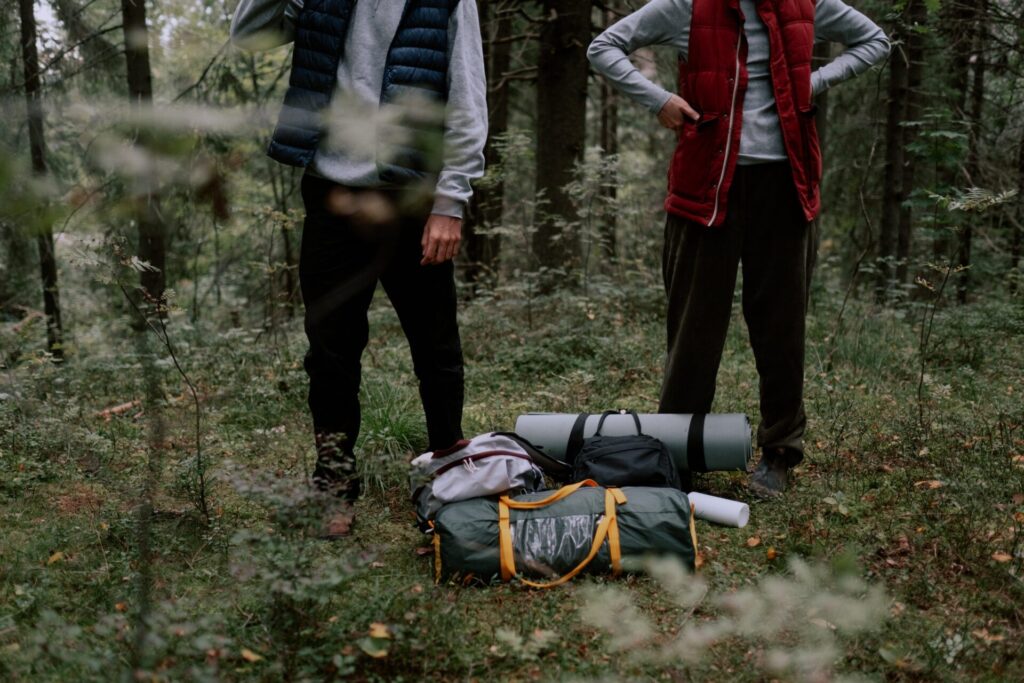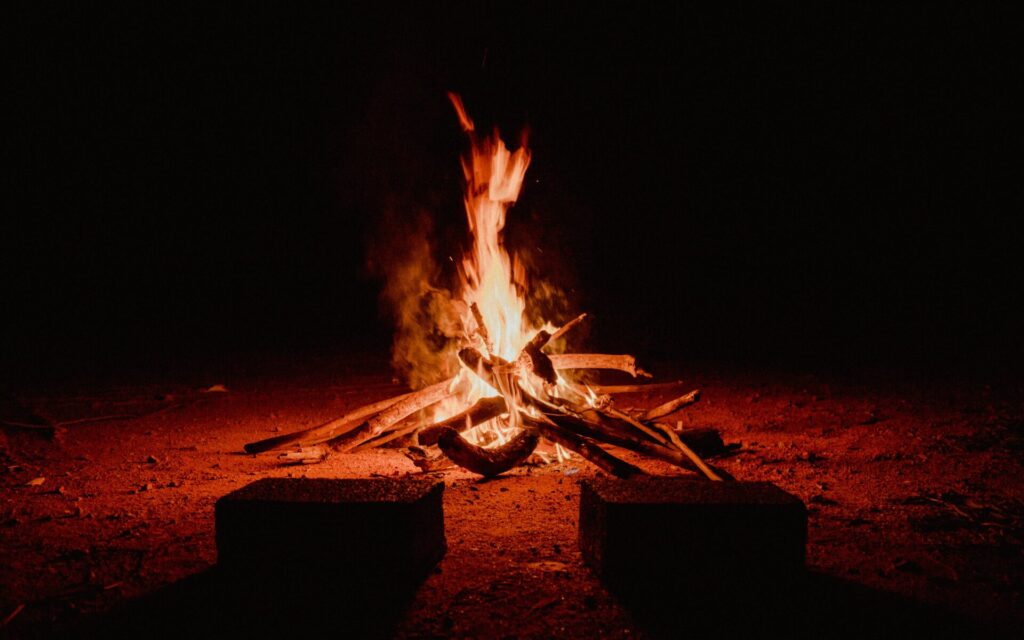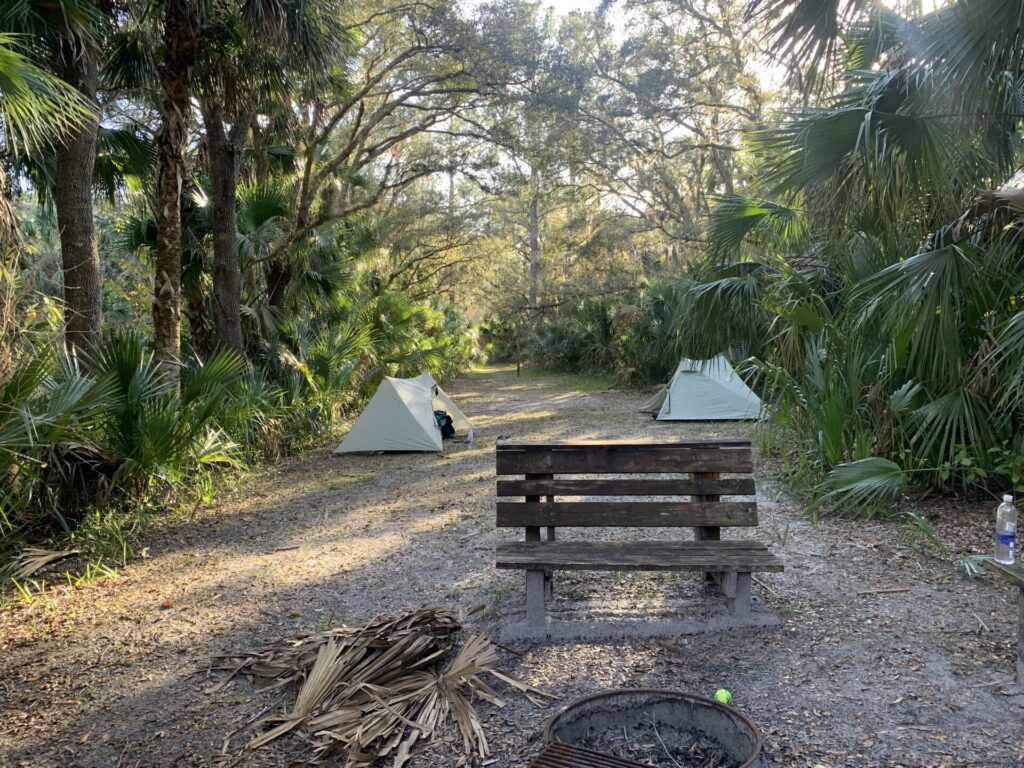My first camping trip was with my local boy scout troop when I was 12 years old. We went to Hocking Hills for a weekend in southeast Ohio. I enjoyed the sandstone cliffs and caves, but in general had a lot of anxiety about camping. It was all very new, I wasn’t comfortable sleeping outside, and I wasn’t a big fan of being away from my home and family. I didn’t stick with scouting for too much longer, and it would be about a decade or so before I would venture back into the world of camping. I met a new girlfriend (now my wife) who was getting into the outdoors herself because she met some friends who were the outdoorsy type. She had most of the gear that I could borrow for this first trip and had a plan for where to go and what to do.
I was fortunate enough to have someone who had gear I could use and could show me the ropes. That’s often the best way to get involved in any new activity. What do you do though if you don’t have that person but still want to get involved in camping? We’ve got you covered below with some important starter tips.
Start with the Essentials

Camping gear can be expensive, but it doesn’t have to be. You can pay $400 for a sleeping pad if you want, but it’s not necessary for the first time you sleep out in your own backyard. Plus, if you’re not sure you want to stick with camping, it’s best to buy modestly priced gear up front and then invest in nicer stuff down the line if you want to stick with it. So, what are the essentials? Check out the list below.
- Tent: Having a decent tent is crucial for a safe and comfortable experience. Shelter is one of the basic needs we humans have, and your tent will be your shelter while you are out camping. It can be the difference between being warm and dry or soaked to the bone. Being cold and wet at night while camping is not a fun experience. You’ll want to think about the size of your group, how cold it will be where you will be camping, and whether you will be backpacking or camping next to your car when you are selecting a tent. Backpacking tents are designed to be light and compact while you carry them, while regular tents designed for car camping are a little heavier and bulkier. Make sure to remember the accessories like stakes when you bring your tent with you!
- Sleeping Bag and Sleeping Pad: Sleeping bags come in two main varieties: down and synthetic. If you are looking for one at an entry level price, you will likely go with synthetic. Down sleeping bags are lightweight, highly compressible, and insulate well in dry conditions. Synthetic sleeping bags are bulkier and heavier than down, but are less expensive. They also retain their insulating properties in wet environments much better than down. The other main consideration with a sleeping bag is the expected temperatures when you will be camping. Sleeping bags are typically provided with a comfort temperature rating and a lower limit rating, both of which can be used as a guide when selecting one. Sleeping pads are used to provide some padding and insulation between your body in the ground. This provides extra comfort and keeps you warmer when camping in cooler weather because your body loses much less heat to the ground when you are sleeping on an insulated sleeping pad.
- Food and Cooking Utensils: When camping, focus on bringing compact, energy dense foods and the means to prepare them. This can be items like peanut butter, trail mix, or macaroni and cheese. There is also a wide selection of dehydrated meals produced by several manufacturers that can be found in your local outdoors store or in places like Walmart. These meals simply require hot water to prepare. Lightweight utensils, pots, pans and mugs are also useful when camping. A portable cooking set can also be used to cook food and prepare hot water. When camping, understand that you are also sharing your space with wild animals who can be attracted to the food that you prepare. If you are car camping, make sure to leave all food in your car at night, and avoid sleeping with food inside your tent. If camping in the backcountry, make sure to follow local guidelines for safely storing your food, particularly if you are sleeping in bear country.
- Extra Water or a Means to Purify It: The human body is over 50% water, and we can’t survive for more than about 3 days without it. If you’re camping in a designated campsite that provides potable water, be sure to bring an extra water bottle so that you can refill often. If backpacking in a remote location, plan to pack in extra water and have a means to purify water sources that you find along the way. This can be accomplished with a water filter, uv disinfection light, or iodine tablets, all of which are available at your local camping store. From staying hydrated to cooking meals, cleaning utensils, and personal hygiene, the significance of water cannot be overstated.
- Proper Clothing and Shoes: Make sure to wear a pair of hiking shoes and proper clothing when camping. Hiking boots provide sturdy support and are more rugged than tennis shoes. Layers and sun protection are a couple key things to keep in mind when thinking about clothing. Layers allows you to add a layer or take a layer off as the temperature changes throughout the day and night. In colder weather a warm base layer directly against your skin is beneficial while a water proof outer layer protects you against rain and snow. Protection from the sun is also critical. Bring sunscreen, UV resistant clothing, and a hat when staying in areas where the UV index will be high.
- Navigation and communication: Don’t rely on cell service everywhere you go. Many places outdoors don’t have reliable cell coverage. With that in mind, it’s important to bring a compass for general navigation, fully charged cell phone, and portable battery bank.
- Fire Starter: Lighters, waterproof matches, and fire starters can be used to provide fire that keeps you warm, helps you cook food, and deters animals and bugs.
- Multi-tool / Knife: These are versatile tools designed to accomplish various tasks for you, including food prep and miscellaneous repairs.

Now that you have an idea of the basic gear to have a successful camping trip, there are a couple final items to cover before stepping out your front door.
- Start Small: Camping for the first time can be an exciting experience, but it is important to stay within your capabilities and experience level to ensure a positive experience. Be realistic about your physical fitness level and don’t try to do too much too soon. Start small by going car camping at a local park not far from your house. If something goes wrong or you don’t enjoy the experience, you can always get in your car and go home! As your confidence grows, so will your capability to take on more adventurous trips.
- Have a Plan: Like the old Scout adage says, be prepared when stepping into the great outdoors. Having a well-thought-out plan is important when embarking on a camping adventure. Review a map of your camping area and trails you plan on hiking before heading out. Check the campsite’s website and social media pages before leaving so that you are up to date on any special events or hazards taking place while you will be there. Review the weather forecast to make sure you are packing the right clothing and gear. Finally, let someone know where you are going and when you plan on coming home.

Camping is a wonderful and fulfilling hobby. Personally, some of my most invigorating moments, where I felt truly alive and in sync with nature, occurred while camping. However, as wonderful as the experience can be, it’s important to be equipped with the proper gear and a solid plan. That can be the difference between having an excellent experience, and one you never want to repeat again. Happy Trails and best of luck with your own camping adventure!
